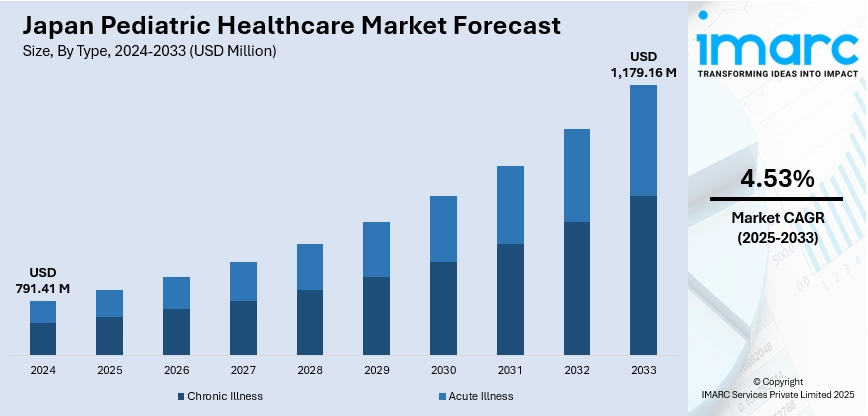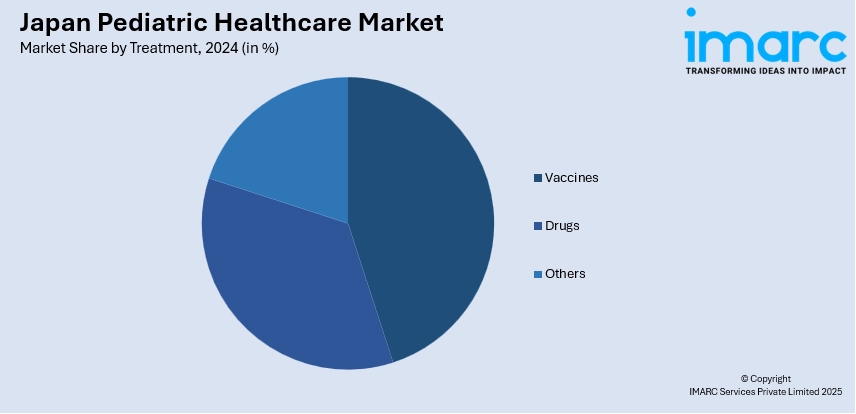
Japan Pediatric Healthcare Market Size, Share, Trends and Forecast by Type, Treatment, and Region, 2025-2033
Japan Pediatric Healthcare Market Overview:
The Japan pediatric healthcare market size reached USD 791.41 Million in 2024. Looking forward, IMARC Group expects the market to reach USD 1,179.16 Million by 2033, exhibiting a growth rate (CAGR) of 4.53% during 2025-2033. The market is experiencing significant growth due to a growing focus on childhood diseases, advancements in pediatric treatments, and government initiatives to improve child healthcare access. The increasing prevalence of chronic conditions and mental health concerns among children is also escalating the demand for specialized care. With enhanced healthcare infrastructure and a focus on preventive measures, the Japan pediatric healthcare market share is further poised for continued growth.
|
Report Attribute
|
Key Statistics
|
|---|---|
|
Base Year
|
2024
|
|
Forecast Years
|
2025-2033
|
|
Historical Years
|
2019-2024
|
| Market Size in 2024 | USD 791.41 Million |
| Market Forecast in 2033 | USD 1,179.16 Million |
| Market Growth Rate 2025-2033 | 4.53% |
Japan Pediatric Healthcare Market Trends:
Aging Population Impact
Japan's aging population is driving a growing need for pediatric healthcare services, with increased focus on child development and long-term health management. As the elderly population rises, the government and healthcare systems are emphasizing early diagnosis and prevention to manage future health challenges. In response to these dynamics, recent legislative changes aim to support families and ensure a healthier future for children. For instance, in June 2024, Japan's parliament passed a law to increase child allowances and parental leave in response to the country's declining birthrate, aiming for equitable support. Starting in October, coverage will be extended to age 18, and benefits for childcare leave will increase amidst concerns about financial barriers impacting family growth. Pediatric care is now seen as part of the broader strategy to ensure a healthier next generation, addressing not only immediate healthcare needs but also fostering long-term well-being. This includes early interventions for childhood diseases and the promotion of healthier lifestyles to combat issues like obesity and diabetes. Additionally, a growing awareness of developmental disorders and mental health concerns in children has led to an increased demand for specialized care. As a result, the aging demographic has indirectly shaped the demand for a more robust and future-ready pediatric healthcare infrastructure in Japan, contributing to Japan pediatric healthcare market growth.

To get more information on this market, Request Sample
Advances in Pediatric Medicine
Advances in pediatric medicine are playing a crucial role in addressing the unique health needs of children. The development of specialized, age-appropriate medications and treatment methods has improved care outcomes for young patients. Unlike adults, children have different physiological responses to medications, making age-specific formulations essential for efficacy and safety. New medications are being developed to treat common pediatric conditions like asthma, diabetes, and epilepsy with higher precision and fewer side effects. For instance, in March 2025, Nippon Shinyaku Co., Ltd. launched Uptravi 0.05 mg tablets in Japan for treating pediatric pulmonary arterial hypertension (PAH). This oral medication addresses a significant need for pediatric treatments, previously limited to injectables. The company continues to focus on developing innovative solutions for rare diseases and enhancing patient care. Moreover, pediatric-specific treatments and vaccines for genetic and developmental disorders are increasingly receiving attention. Rapid progress in non-invasive diagnostic technologies, including wearables for monitoring the health of children, is also making interventions timelier and more precise. Such pediatric advances in medicine not only increase treatment efficacy but also ensure that children get the best care possible, specific to their needs, and have a strong influence on the Japan pediatric healthcare market.
Japan Pediatric Healthcare Market Segmentation:
IMARC Group provides an analysis of the key trends in each segment of the market, along with forecasts at the country and regional levels for 2025-2033. Our report has categorized the market based on type and treatment.
Type Insights:
- Chronic Illness
- Acute Illness
The report has provided a detailed breakup and analysis of the market based on the type. This includes chronic illness and acute illness.
Treatment Insights:

- Vaccines
- Drugs
- Others
A detailed breakup and analysis of the market based on the treatment have also been provided in the report. This includes vaccines, drugs, and others.
Regional Insights:
- Kanto Region
- Kansai/Kinki Region
- Central/Chubu Region
- Kyushu-Okinawa Region
- Tohoku Region
- Chugoku Region
- Hokkaido Region
- Shikoku Region
The report has also provided a comprehensive analysis of all the major regional markets, which include Kanto Region, Kansai/Kinki Region, Central/Chubu Region, Kyushu-Okinawa Region, Tohoku Region, Chugoku Region, Hokkaido Region, and Shikoku Region.
Competitive Landscape:
The market research report has also provided a comprehensive analysis of the competitive landscape. Competitive analysis such as market structure, key player positioning, top winning strategies, competitive dashboard, and company evaluation quadrant has been covered in the report. Also, detailed profiles of all major companies have been provided.
Japan Pediatric Healthcare Market News:
- In July 2024, Japan's Pharmaceuticals and Medical Devices Agency (PMDA) announced the launch of the "Pediatric and Rare Disease Drug Consultation Center". This initiative supports simultaneous drug development for adults and children, offering subsidized consultation fees, including a waiver for specific requests.
- In March 2024, AstraZeneca and Sanofi received approval in Japan for Beyfortus (nirsevimab), a treatment aimed at preventing RSV-related lower respiratory tract disease in infants. This represents a significant advancement, as it is the first preventive option available for all infants at risk during their first and second RSV seasons. The medication is expected to be available for the 2024/25 season.
Japan Pediatric Healthcare Market Report Coverage:
| Report Features | Details |
|---|---|
| Base Year of the Analysis | 2024 |
| Historical Period | 2019-2024 |
| Forecast Period | 2025-2033 |
| Units | Million USD |
| Scope of the Report |
Exploration of Historical Trends and Market Outlook, Industry Catalysts and Challenges, Segment-Wise Historical and Future Market Assessment:
|
| Types Covered | Chronic Illness, Acute Illness |
| Treatments Covered | Vaccines, Drugs, Others |
| Regions Covered | Kanto Region, Kansai/Kinki Region, Central/Chubu Region, Kyushu-Okinawa Region, Tohoku Region, Chugoku Region, Hokkaido Region, Shikoku Region |
| Customization Scope | 10% Free Customization |
| Post-Sale Analyst Support | 10-12 Weeks |
| Delivery Format | PDF and Excel through Email (We can also provide the editable version of the report in PPT/Word format on special request) |
Key Questions Answered in This Report:
- How has the Japan pediatric healthcare market performed so far and how will it perform in the coming years?
- What is the breakup of the Japan pediatric healthcare market on the basis of type?
- What is the breakup of the Japan pediatric healthcare market on the basis of treatment?
- What is the breakup of the Japan pediatric healthcare market on the basis of region?
- What are the various stages in the value chain of the Japan pediatric healthcare market?
- What are the key driving factors and challenges in the Japan pediatric healthcare market?
- What is the structure of the Japan pediatric healthcare market and who are the key players?
- What is the degree of competition in the Japan pediatric healthcare market?
Key Benefits for Stakeholders:
- IMARC’s industry report offers a comprehensive quantitative analysis of various market segments, historical and current market trends, market forecasts, and dynamics of the Japan pediatric healthcare market from 2019-2033.
- The research report provides the latest information on the market drivers, challenges, and opportunities in the Japan pediatric healthcare market.
- Porter's five forces analysis assist stakeholders in assessing the impact of new entrants, competitive rivalry, supplier power, buyer power, and the threat of substitution. It helps stakeholders to analyze the level of competition within the Japan pediatric healthcare industry and its attractiveness.
- Competitive landscape allows stakeholders to understand their competitive environment and provides an insight into the current positions of key players in the market.
Need more help?
- Speak to our experienced analysts for insights on the current market scenarios.
- Include additional segments and countries to customize the report as per your requirement.
- Gain an unparalleled competitive advantage in your domain by understanding how to utilize the report and positively impacting your operations and revenue.
- For further assistance, please connect with our analysts.
 Request Customization
Request Customization
 Speak to an Analyst
Speak to an Analyst
 Request Brochure
Request Brochure
 Inquire Before Buying
Inquire Before Buying




.webp)




.webp)












